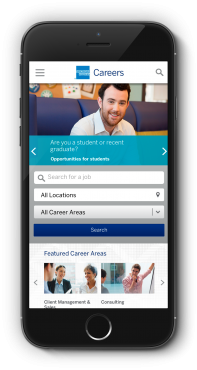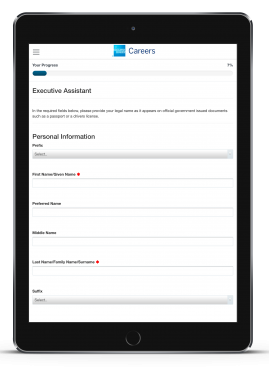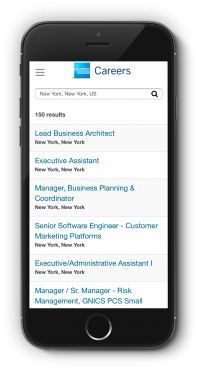On the Cutting Edge: The ‘Entrepreneurial’ Recruiting Style of American Express

“We want every touchpoint with us to be like a mirror of how good it is to work at [our company],” says Oriana Vogel, head of global recruitment at American Express. “We want it to be an incredibly flawless customer service process. The same way we would deliver stellar experiences to our card members — we want our candidates to feel the same thing.”
Noble sentiments for sure, but they’re not exactly new or original. After all, isn’t that what the whole candidate experience movement has been about at its core — i.e., building recruiting processes that serve candidates the way our companies serve customers?
Well, yes, but there’s a reason Vogel and AmEx deserve special attention — two reasons, actually. First, because Vogel introduced me to the concept of “entrepreneurial recruiting,” an idea that I desperately want to share with our readers; and second, because under Vogel’s watch, AmEx has rolled out what may be the most impressive large-scale recruiting process I’ve seen in all my time as a writer in this space.
Entrepreneurial Recruiting: Where the Recruitment Marketers Are Actually Marketers
According to Vogel, AmEx approaches recruiting “in an entrepreneurial way.” What that means, exactly, is that AmEx runs the recruiting department as if it were its own separate business.
“We think about our company almost as the product or service that we are marketing to candidates around the world,” Vogel explains. “Just like if you were selling toothpaste, you would need to do deep analytics about what kind of customer you can attract and the best way to reach them — we do the same with our candidates. We consider our roles the product, and we’re looking to sell that to the people around the world.”
Again, this isn’t an entirely new concept — it’s basically just a really great description of what “employer branding” is — but Vogel and her team separate AmEx from the competition by really committing to the idea of running the recruiting department as if it were a specific business selling a specific product or service.

“Part of my team is a recruitment marketing and branding team that is staffed by marketers,” Vogel says. “It is not staffed by recruiters who want to do marketing in their spare time. It’s staffed by people who came up in the consumer packaged goods space, and they do the analytics on what would be attractive to our candidates, and they help us segment where those people work and live and what excites them.”
It doesn’t end there, of course: AmEx’s recruiting team continually relies on these marketers and their data analytics to help them keep candidates engaged throughout the entire process. It all goes back to the idea of treating candidates exactly like you would consumers — and it seems to be working quite well for AmEx.
A Broader Candidate Pool That Better Meets the Company’s Needs
Vogel says that this entrepreneurial recruiting approach has really upped the overall quality of candidates and provided AmEx with a broader candidate pool that better meets the company’s needs.
“If we weren’t actively marketing, we would only attract the people who already know about AmEx or who identify with us already,” Vogel says. “We would see the same sources come in over time. But when we’re more actively articulating our strategy, we’re able to market to new groups, and we see a very different candidate pool as a result.”
For example, Vogel points to AmEx’s recent forays into the world of hackathons.
“When we set up hackathons for the tech community, we’re reaching an audience that may not have considered AmEx as an employer previously,” Vogel says.
As a result of these hackathon sponsorships, AmEx has been able to tap into younger, more tech-savvy talent than the company was previously able to.
Keep Listening to Your Customers

“We actively survey our candidates. Once the process is over, [we ask them], ‘What do you think’?” Vogel says. “We survey both the candidates who get jobs and those who interview with us but ultimately do not get jobs. We get a Net Promoter Score, just like our entire business does.”
This way, Vogel says, the recruiting department is “able to track scores over time and drill down to understand what is working well and what needs to be enhanced.”
Rome Wasn’t Built in a Day
Another important lesson employers can learn from AmEx is that building a great, cutting-edge recruiting process takes time, planning, and a carefully executed strategy. It’s not as if Vogel woke up one day and decided AmEx was going to recruit entrepreneurially. No, AmEx’s new recruiting process has been in the works for roughly five years now.
“Before we jumped wholesale into hiring marketers and working with ad agencies, we focused on some of our infrastructure fundamentals,” Vogel explains. “What we didn’t want to do was get ahead of ourselves and go out to the candidate marketplace and be unable to manage the inflow. We needed to make sure our ATS and our reporting tools and compliance processes — all the tech and operations stuff — was up to code. That’s not glamorous, but it’s the piping that allows us to be stable.”
And once the “piping” was in place, Vogel says, then AmEx was able to “place the entrepreneurial approach on top of it.”
And Now, a 165-Year-Old Company Is Schooling the New Kids
Vogel knows that some candidates might see American Express and think, “Oh, it’s such an old company. It’s really big, and it’s really corporate. I don’t want to work in that kind of setting.” That’s why she’s put so much effort into building a recruiting process that is truly new and truly exciting.

For example, Vogel notes that AmEx allows candidates to apply through mobile devices, and that the company receives about 30 percent of its candidates through mobile devices. This may not sound like much, but consider the fact that, when AmEx instituted its mobile apply process, only 5 percent of Fortune 500 companies allowed candidates to apply for jobs via mobile devices.
Vogel calls this sort experience — when a candidate encounters the things that differentiate AmEx’s recruiting process from the processes of other major corporations — a “moment of truth.” She notes that by purposefully engineering such moments in the recruiting process, AmEx can show candidates that the company’s culture may be more exciting than they thought it was.
“We sort of embed [these moments of truth] throughout the whole candidate life cycle process to reflect to the candidates that we are a digital company,” Vogel says.
And AmEx also takes great pains to position itself as a global company. Vogel notes that AmEx wants every candidate, no matter where they’re applying from, to have similarly enjoyable experiences.
“When we put these solutions in place, we knew we couldn’t just offer them in English only, or do things one way in the U.S. and overlook India or Mexico, for example,” Vogel says. “Every single technology is fully translated into the markets we support.”
The result of all this is a recruiting process unlike any other I’ve ever seen: it’s a recruiting process that talks a big game, and then actually backs it up.
So, I offer this portrait of AmEx’s recruiting process as a way to say, “Hey, employers, take note.” You don’t have to continue paying lip service to the idea of taking recruiting to the next level. No, you can actually do it.

